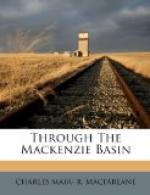Next morning rowing took the place of poling and tracking for a time, and, presently, the great range of lofty hills called, to our right, the Moose Watchi, and to our left, the Tuskanatchi—the Moose and Raspberry Mountains—loomed in the distance. Here, and when only a few miles from the lake, a York boat came tearing down stream full of lithe, young half-breed trackers—our long-expected assistants from the Hudson’s Bay Company’s post, as we would have welcomed much more warmly had they come sooner, for we had little but the lake now to ascend, up which a fair breeze would carry us in a single night.
Doubtless it would have done so if it had come; but the same head-winds and storms which had thwarted us from the first dogged us still. We had camped near the mouth of Muskeg Creek, a good-sized stream, and evidently the cause hitherto of the Lesser Slave’s rich chocolate colour; for, above the forks, the latter took its hue from the lake, but with a yellowish tinge still. From this point the river was very crooked, and lined by great hay meadows of luxuriant growth. Skirting these, reinforced as we were, we soon pulled up to the foot of the lake, where stood a Hudson’s Bay Company’s solitary storehouse. There some change of lading was made, in order to reach “the Island,” some seven miles up, and the only one in the lake, sails being hoisted for the first time to an almost imperceptible wind.
The island, where we were to camp simply for the night—as we fondly thought—was found to be a sprawling jumble of water-worn pebbles, boulders and sand, with a long narrow spit projecting to the east, much frequented by gulls, of whose eggs a large number were gathered. To the south, on the mainland, is the site of the old North-West Company’s post, near to which stood that of the Hudson’s Bay Company, for they always planted themselves cheek by jowl in those days of rivalry, so that there should be no lack of provocation. A dozen half-breed families had now their habitat there, and subsisted by fishing and trapping. On the island our Cree half-breeds enjoyed the first evening’s camp by playing the universal button-hiding game called Pugasawin, and which is always accompanied by a monotonous chant and the tom-tom, anything serving for that hideous instrument if a drum is not at hand. They are all inveterate gamblers in that country, and lose or win with equal indifference. Others played a peculiar game of cards called Natwawaquawin, or “Marriage,” the loser’s penalty being droll, but unmentionable. These amusements, which often spun out till morning, were broken up by another rattling storm, which lasted all night and all the next day. We had lost all count of storms by this time, and were stolidly resigned. The day following, however, the wind was fresh and fair, and we made great headway, reaching the mouth of Swan River—Naposeo Sepe—about mid-day.
This stream is almost choked at its discharge by a conglomeration of slimy roots, weeds and floatwood, and the banks are “a melancholy waste of putrid marshes.” It is a forbidding entrance to a river which, farther up, waters a good farming country, including coal in abundance.




